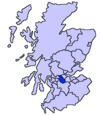Longriggend
 From Wikipedia the free encyclopedia
From Wikipedia the free encyclopedia




Longriggend is a village in North Lanarkshire, Scotland, with a population of approximately 200.
Geography
[edit]It is situated on moorland 8 km north-east of Airdrie, in the parish of New Monkland. It is roughly halfway between Upperton and Caldercruix.
History
[edit]The village appeared on a map by Timothy Pont, under the name of Langrodge. It was published in 1596 but the letters are difficult to read.[1] The toponymy is listed along with other -rigg placenames.[2] Longriggend is also shown on another map by Roy c1754.[3] Slamannan Railway joined Longriggend with Airdrie and the Union Canal in 1840, but its gauge prevented its connection with the Edinburgh & Glasgow Railway. Coal pits in the area used the railway extensively,[4] and by 1895 there was a station at Longriggend.[5] By 1901 its population had reached over 1500, and it had a post and telegraph office, and an inn nearby.[6]
Education
[edit]The Ordnance Survey in 1867 recorded a Roman Catholic school in the village.[7]
Sport
[edit]The village hosted a senior football club, Longriggend F.C., between 1897 and 1902. Its greatest honour was winning the Coatbridge Express Cup[8] in 1897–98, beating Albion Rovers in the final.[9]
Longriggend Fever Hospital and Remand Institution
[edit]Historically, there was a tuberculosis sanitorium in the part of the village now known as Upperton.[10] The hospital was converted into Longriggend Remand Institution which has now been closed[11] and demolished.[12]
- Blaeu's map from 1654[13] based on Pont's original c.1596[14] "The East Central Lowlands (Stirling, Falkirk & Kilsyth) - Pont 32" map depicting Langrig west of Slamannenn
- Longriggend from Blaeu's map[15] based on Pont's original[16] It is near the top right of the map and Langrodge is about three squares left of the Black Loch.
References
[edit]- ^ "Glasgow and the county of Lanark - Pont 34". Maps of Scotland. Timothy Pont (16th century). Retrieved 31 December 2017.
- ^ Drummond, Peter, John (2014). An analysis of toponyms and toponymic patterns in eight parishes of the upper Kelvin basin (PDF). Glasgow: Glasgow University. p. 354. Retrieved 3 July 2017.
{{cite book}}: CS1 maint: multiple names: authors list (link) - ^ "Roy's map of the Lowlands". National Library of Scotland. Retrieved 3 January 2018.
- ^ Dron, Robert W. (1902). The Coal-fields of Scotland. London: Blackie & Son. p. 157. Retrieved 3 February 2018.
- ^ "O.S. Map with zoom and Bing overlay". National Library of Scotland. Ordnance Survey. Retrieved 30 December 2017.
- ^ The Making of Scotland, Robin Smith, Canongate Books Ltd, 2001, ISBN 1-84195-170-6
- ^ History of Longriggend, accessed 18 February 2011
- ^ The consolation competition for the Lanarkshire Cup.
- ^ "Lanarkshire notes". Scottish Referee: 2. 6 May 1898.
- ^ "25 inch O.S. map with OpenStreetMap overlay". National Library of Scotland. Retrieved 4 January 2018.
- ^ "High-security prison opens its doors to Hollywood". The Scotsman. 13 June 2004. Retrieved 4 January 2018.
- ^ Tonner, Judith (29 July 2009). "Developer plans 240 houses for Upperton". Daily Record. Retrieved 4 January 2018.
- ^ Blaeu, Joan. "Sterlinensis praefectura, Sterlin-Shyr". National Library of Scotland. Retrieved 30 December 2017.
- ^ Pont, Timothy. "The East Central Lowlands (Stirling, Falkirk & Kilsyth) - Pont 32". National Library of Scotland. Retrieved 9 August 2016.
- ^ Blaeu, Joan. "Glottiana Praefectura Inferior". National Library of Scotland. Retrieved 30 December 2017.
- ^ "Glasgow and the county of Lanark - Pont 34". Maps of Scotland. Timothy Pont (16th century). Retrieved 31 December 2017.
55°54′35″N 3°53′07″W / 55.9097°N 3.8852°W
![Blaeu's map from 1654[13] based on Pont's original c.1596[14] "The East Central Lowlands (Stirling, Falkirk & Kilsyth) - Pont 32" map depicting Langrig west of Slamannenn](http://upload.wikimedia.org/wikipedia/commons/thumb/1/19/Blaeu_-_Atlas_of_Scotland_1654_-_STERLINENSIS_-_Slamannan.jpg/318px-Blaeu_-_Atlas_of_Scotland_1654_-_STERLINENSIS_-_Slamannan.jpg)
![Longriggend from Blaeu's map[15] based on Pont's original[16] It is near the top right of the map and Langrodge is about three squares left of the Black Loch.](http://upload.wikimedia.org/wikipedia/commons/thumb/0/07/Blaeu_-_Atlas_of_Scotland_1654_-_GLOTTIANA_PR%C3%86FECTVRA_INFERIOR_-_Longriggend.png/316px-Blaeu_-_Atlas_of_Scotland_1654_-_GLOTTIANA_PR%C3%86FECTVRA_INFERIOR_-_Longriggend.png)
